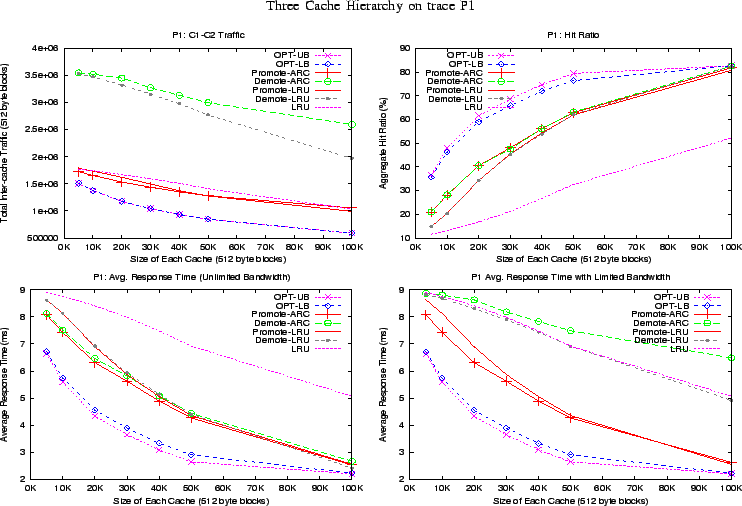 |

 |
Increasing the complexity of the hierarchies we study, we now turn to a three-level (three equal size caches) hierarchy.
As in the two-level case, we present detailed results for the first trace P1 in Figure 13. The other traces had similar results but we do not present plots for lack of space.
We observe that for the wide variety of traces and cache sizes, PROMOTE outperforms DEMOTE in three-level caches as well:
Inter-cache Bandwidth Usage: PROMOTE is ![]() x more efficient than DEMOTE
which uses
x more efficient than DEMOTE
which uses ![]() % (
% (![]() % resp.) more bandwidth between
% resp.) more bandwidth between ![]() and
and ![]() and
and
![]() % (
% (![]() % resp.) more bandwidth between
% resp.) more bandwidth between ![]() and
and ![]() , when compared to
PROMOTE-LRU (PROMOTE-ARC, respectively).
, when compared to
PROMOTE-LRU (PROMOTE-ARC, respectively).
Aggregate Hit Ratio: PROMOTE same as DEMOTE.
Hits in the Highest Cache: PROMOTE achieves ![]() % and
% and ![]() % more hits in
the top two caches than DEMOTE for the LRU and ARC variants, respectively.
% more hits in
the top two caches than DEMOTE for the LRU and ARC variants, respectively.
Average Response Time: When bandwidth is not limited and demotions are free,
PROMOTE beats DEMOTE by ![]() % and
% and ![]() % on the average response
time for LRU and ARC variants, respectively. For a limited bandwidth case, where we allow
% on the average response
time for LRU and ARC variants, respectively. For a limited bandwidth case, where we allow ![]() blocks per second (
blocks per second (![]() x times
x times
![]() ),
When we average the response time across all cache sizes, we observe that
PROMOTE substantially outperforms DEMOTE by achieving lower response times,
),
When we average the response time across all cache sizes, we observe that
PROMOTE substantially outperforms DEMOTE by achieving lower response times,
![]() ms (for ARC) and
ms (for ARC) and ![]() ms (for LRU), as compared to DEMOTE with
ms (for LRU), as compared to DEMOTE with ![]() ms (for ARC) and
ms (for ARC) and ![]() ms (for LRU), respectively.
ms (for LRU), respectively.